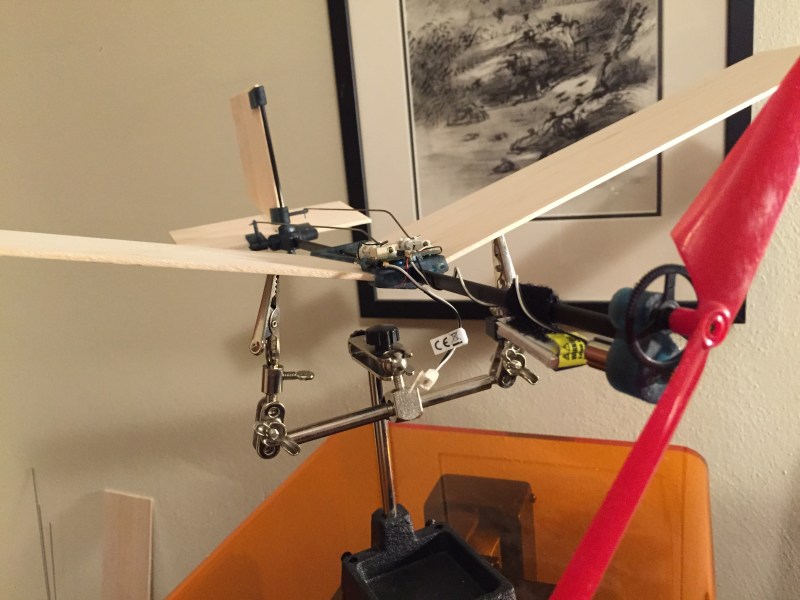One of our avid readers, [Niklas Melton] loves RC planes. After getting into 3D printing, the next logical step was to start building is own planes… And now he’s done it!
He calls it the Air-Form 1 Micro RC plane, paying homage to the FormLabs resin printer he used. All of the parts except for the electronics were printed using a tough resin. It’s designed to take balsa wood wings into clips he designed into the parts. A 150mAh battery provides the power with a motor that exerts about 54g of thrust — not bad considering the entire thing only weighs 60g! Unfortunately he doesn’t have any video clips of it flying, though he assures us it does indeed fly — if you’re interested in building your own, he’s uploaded all the files to a page on Thingiverse.
As more advanced 3D printers come down in price, like the SLA technology, it becomes possible to design and 3D print even more complex parts. Some of the resins available have now some pretty amazing properties. One of our readers replaced a servo spline gear with one he printed — which works even better than the original!















hm…. would printing the wings as partially hollow make them lighter than balsa?
probably not on a model this small, but for a bigger model with a lot more massive wings, I suspect that could work
At the moment it is possible to print a wing, but you face two constraints (this is specific to SLS, which in my opinion is the most suitable technology for wing fabrication). The first is that the density of SLS Nylon is 10-11 times higher than balsa. In addition, you usually need to abide by design rules, the most significant of which is the 0.8mm wall thickness. Typically, you can achieve reasonable results with chord lengths of greater than 100mm. The second constraint is machine volume. At the moment, you really can’t fabricate long spans. Also, because most AM service providers charge per unit cubed of machine space, printing wings is amazingly expensive. UAV printing would be much simpler if wall thickness went down, the build volumes went up and pricing was based on material used (not bounding box space).
What about using struts and then covering them in wing foil? That should work, and would allow for part-by-part construction as well. The airfoil itself would not be 3d printed at that point, but meh.
Sure, you could cover it, but that’s how RC planes have been made for the better part of the century. There is an elegance in a completely printed wing. It provides an accurate reproduction of your outer mould lines and there’s little post-processing to go from printer to a low-RE wing.
You could make skeleton wings and stretch cling-wrap around them.
IIRC the one method is that you use thin paper, glue it down on the edges of the skeleton, then mist it with water. It dries and shrinks to a tight fit.
Balsa wood is already “partially hollow” on a much more fundamental level than can be achieved by a 3d printer.
If you are looking to increase the strength of the balsa wings, why not simply spray coat them with a thin layer of a polyurethane varnish? Slight increase in weight, granted, but should make them slightly stiffer/stronger.
I originally wanted to print the wings hollow and make the entire plane printable but scale simply wouldn’t allow it. On this scale, half of the weight come from the necessarily non-printed parts like the motor and batteries and actuators. You’d need to increase your size up to the meter or more wingspans to be able to start lifting the sort of weight wed be talking but at that point you’re going to start needing wing struts. Even without a strut the wings may barely be able to lift themselves. the Resin I used has a similar density to PLA and ABS. About 1.1 g/cm3. Which is slightly more dense than water. The plastics just arent well suited for an entire wing body.
I did also really think about shrink wrapping a mesh frame or a strut-spar wing. Perhaps the next step will be to scale up and try these methods.
I enjoy the discussion! Theres a lot of room for 3D printing in RC aviation because of how easy and cheap replacement parts would be.
http://hackaday.com/2013/09/13/students-build-a-3d-printed-plane/
The trick is to make it a rocket. That little bird flies at 45 mph.
That classic way to cover model plane wings was to glue on a special tissue paper then coat it with a paint called airplane dope. The dope caused the tissue to shrink as it dried. Do it wrong and it could warp or break the balsa structure, or not shrink tight. It was also rather fragile.
Then along came Mono-Kote. Peel, stick, use a heat gun to shrink out the wrinkles. No mess, no highly flammable dope. Very easy to do multiple colors with razor sharp lines.